A couple of weeks ago I came to the end of the piece of yellow cotton we’ve been using for the patchwork altar frontal. A slightly panicky rummage revealed there was no more. Our local patchwork shop had what seemed a very good match, but ninety diamonds later, as I began joining the stars into constellations the yellow was too pale and anaemic. There was no chance of getting a repeat of the material now embedded in two thirds of the patchwork (Laura Ashley 1980s vintage) so before me were two alternatives. Either I could go along with the slightly less bright yellow of the latest cutting on the basis that in hand crafting such irregularities happen (kilim rugs look wonderful with shades changing mid weave with a suddenness and regularity that only adds to their beauty). Or, I could submit my latest piece of fabric to a bit of shade adjustment and try my luck with a packet of Dylon Machine Wash, Sunflower Yellow (which I did happen to have already).
Several wash cycles of ever diminishing amounts of dye followed by washes with ever smaller squirts of liquid bleach later I felt I was getting somewhere – now the yellow just needed damping down with a more earthy tone. So it was with do or die desperation that I filled the sink up with a gallon of teabag tea into which I dropped the poor tortured fabric. Amazing to relate it is perfect! I defy anyone to detect a difference. My only hope now is that I haven’t degenerated the fabric to the point at which it disintegrates completely in a few year’s time…
Which niggling worry got me thinking of Middlemarch. The great – but also most frustrating – thing about being a librarian is that you shelve all sorts of books you’d rather like to sit down and get your head into – immediately . As you can’t ever really do this (well, perhaps ever so occasionally in the depth of the vacations – if you’re lucky), I tended to stuff little notes hieroglyphic with shelf marks and personal shorthand about my person – never having any pockets, the usual place was tucked into my bra which meant at bed time the divestment of clothing also released a confetti of bits of paper rather as if I was nightly shedding a layer of skin. The vicar of course became accustomed to this and never batted an eye lid.
Well the truth is that you never get around to reading most of these books, but Middlemarch in the 21st century ed Karen Chase (OUP 2006) did get taken home and the essay by Gillian Beer : What’s not in Middlemarch was a revelation to me, detailing the book’s textile background and easily missed subtext. In the book itself (published in 1870; set in 1830) George Eliot dwells little on this background knowledge but Gillian Beer makes the point that readers contemporaneous with the book would have known about it and George Elliot takes this knowledge for granted in her novel.
“Fabric is the key metaphor of the novel” (Gillian Beer) and the weaving and dyeing imagery highlights the different levels of society, their interaction and their attendant health. Middlemarch itself is a centre for dyeing the fabric which is still made on domestic hand looms in the surrounding villages. Mrs Cadwallader regards Mr Vincy, the mayor and father of ‘hero’ Fred as, a good fellow yet she also describes him as “one of those (manufacturers) who suck the life out of the wretched handloom weavers in Tipton and Freshitt.” The cloth they produce is dyed using manganese, a new method which produces bright new colours but which rots the silk. Both Featherstone and Bulstrode have made money from manganese mines in the Midlands – and this is the money that may or may not go to Fred Vincey. Bulstrode is also involved in the great Plymdale dyeing house and is keen to keep the price of the hand loomed fabric as low as possible in order to maximize his profits. As the fine hand made fabric is rotted by the manganese dye, so is the lot of the hand loom workers degraded and demeaned. Manganese and managers rot silk literally and manual loomworkers metaphorically hand in hand. In 1830s Coventry (George Eliot’s home town) had 13,000 hand looms supporting 30,000 people. What’s not in Middlemarch are these silent workers who at this stage in the C19th have yet to find political expression.
Gillian Beer takes historical context one step further and looks at the physical form of the first publication. Middlemarch originally appeared in 8 paperback books each of which came with advertisements – ” in some cases the unironic juxtaposition of text and advertisement seems positively scandalous now”. Perhaps most ironical is the advert for Judson’s Simple Dyes which commends their use as clean, simple, economical and even an ideal as an amusing hobby activity for young ladies with too much time on their hands in line with sewing or knitting. Of course by 1870 when the book was published, new aniline dyes and chromolithography had superseded cruder dyes although we do now know that, though aniline dyes do not rot the fabric, they’re not in fact very good for the environment. Which brings me back to to where I began and to wondering about my own dyeing activity. I think I’ll just have to embrace the uncertainty and I’m thinking kilim rugs again. In 20 years time, should my dyeing not prove to be stable, somebody might even think the use of two different colours for the linking diamonds was all part of the original design. (Fingers crossed).
I love yellow – as my accompanying photographs illustrate.
Our Sewing Bee last Saturday was very successful. One brave soul took up the challenge to have a go at embroidering a flower and this appears above. She did it in Anguilla when she accompanied her husband for his work and she has no idea what it is. I like the idea it will be a nameless exotic in a patchwork field of local plants – but when it comes down to it, humans or plants, we’re probably all mongrels now.

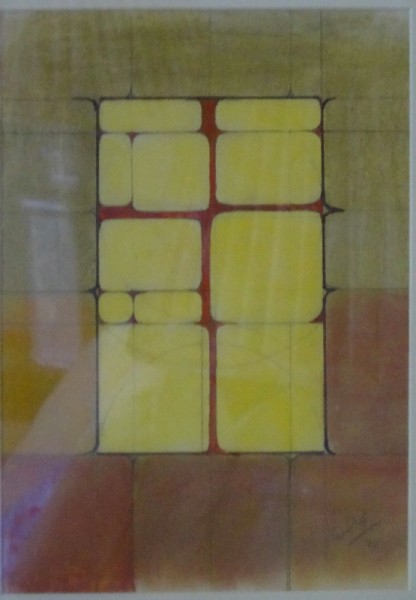
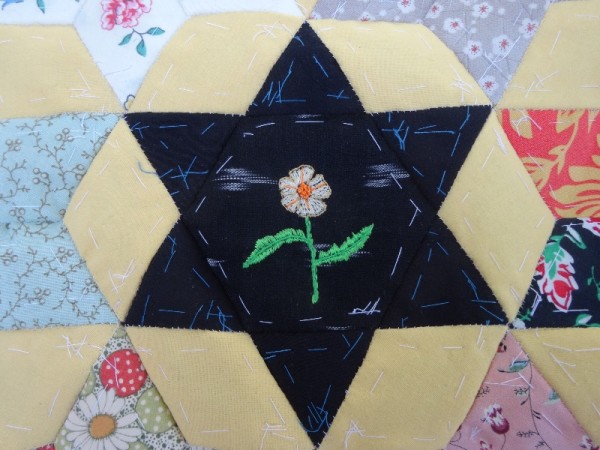
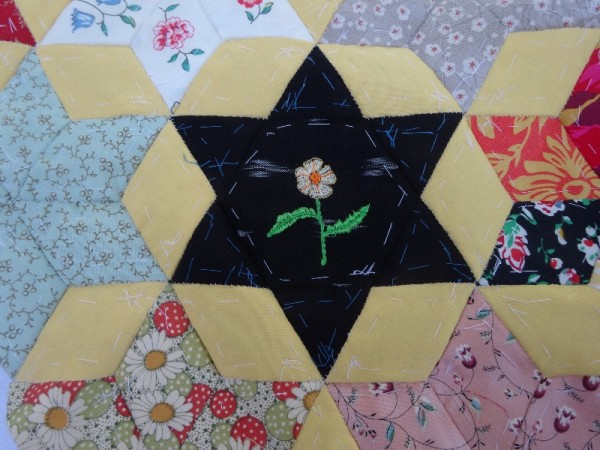
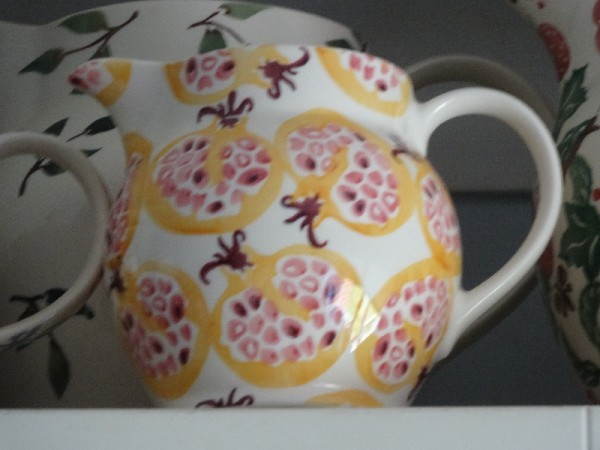
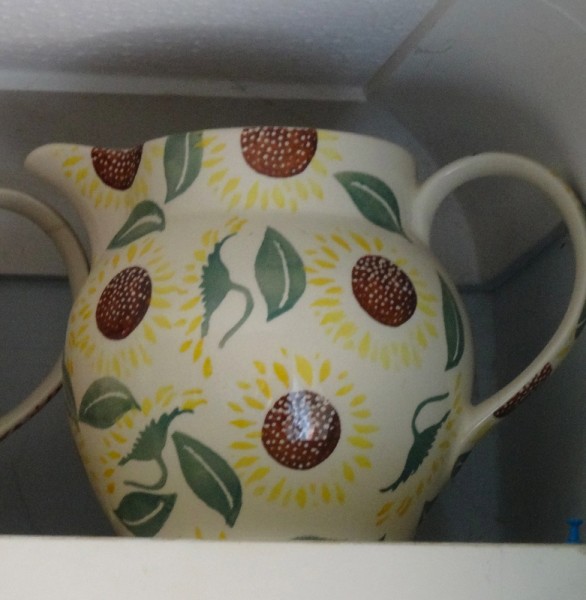
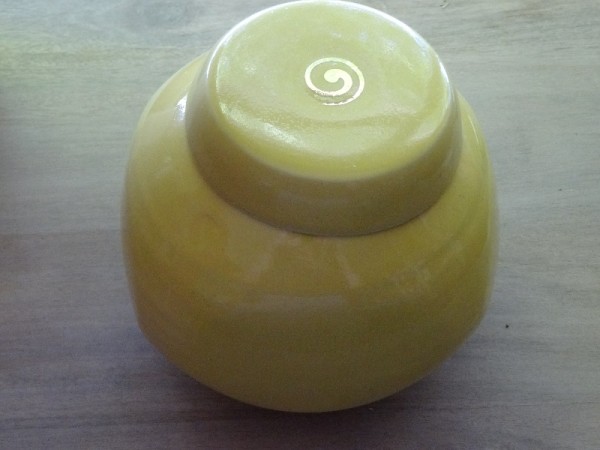
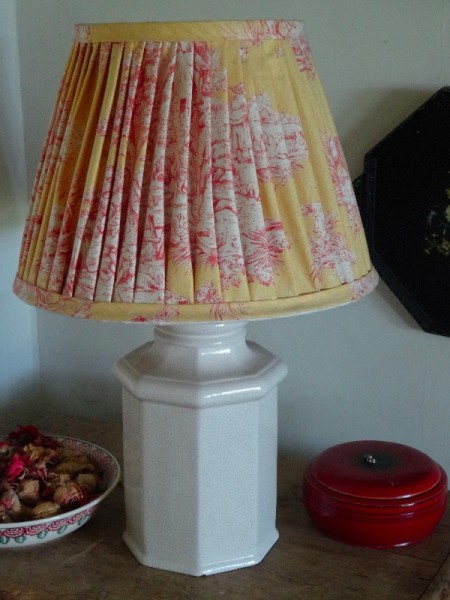
8 Comments
I certainly hope your efforts don’t degrade. I’m impressed by the ingenuity you displayed, and even more by your managing to get such a perfect match!
Kind thoughts Rachel and much appreciated. Do I remember rightly that you’ve had to tweak the colour of fabric you’ve used too?
Mary, I read this yesterday and, once more, you sent me on a textile and literary trail of threads that lasted several hugely enjoyable hours.
I covet David Addison’s picture. It ought to be widely reproduced not only on paper but fabric, too. A future altar piece perhaps?
A few years ago at the small-but-perfect Wells Poetry Festival we were riveted by Gillian Beer’s unforgettable, dazzling talk on Lewis Carroll, in particular her hilarious reading of a note his father wrote to him, a young boy, in reply to Lewis’s request for – I think – nails or screws from a Leeds’ ironmonger.
Apropos an earlier exchange with you: if you’ve a little spare time, do search online for “John Craske + YouTube”. We went to a talk last week with Julia Blackburn on her book about Craske, and will be visiting the Peter Pears Gallery at Aldeburgh next week for an exhibition of his embroidered pictures.
Thank you for your own dazzling words and pictures, Mary.
Penny, when I read this, it quite made my day – for so many reasons! I’m really pleased it sent you off on your own quest that gave you such pleasure. David was also delighted to hear your enthusiasm for his painting.
Lucky you hearing Gillian Beer and lucky you doubled enjoying a festival that was (is still?) ‘small-but-perfect’.
While I was reading your comment Julia Blackburn’s book on John Craske was lying on the table beside my laptop – bought just last week. I shall being following up your YouTube recommendation shortly.
Many thanks for such an interesting comment.
Another fascinating read Mary. I must take up Middlemarch again and reread. I had no idea that it was so closely related to the textile industry of the time and that the novel was set against this subtext. Or, perhaps, it is some years since my last read and I have forgotten. Nevertheless the book is now on my books to read this year list.
I am so pleased you managed to match the colour so well – if the fibres have been damaged by this process then so be it… it is all part of the history of the piece.. and to my mind makes it so much more wonderful too.
I have just made half of a star after attending an english paper piecing class. I was shocked that they all seem to use glue to stick the pieces onto the papers. I am going to buck the trend and stubbornly sew my hexagons and diamonds by hand and remove the papers later. What do you think? They also use a synthetic thread for stitching – perhaps their sewing is all about speed and product whereas mine is most probably about the process.
The study in pastel I find rather peaceful and serene and would very much like it to grace my walls too.
Glad you had your little grey cells tickled by Middlemarch – there’s so much different to pick out every time you come back to it.
Thank you for your thoughts about my own dyeing experiments – I’m in complete agreement with what you say and now I’m not going to think about it any more.
I’m a bit taken aback by the glue and patchwork and I don’t think I’d enjoy doing that anywhere as much as sewing. The slightly dubious thing I have done with the diamonds of the altar frontal was to use thinnish iron on vilene for the diamonds which will cut down on the time as we won’t have to take papers out. You have to be careful though because as it is thinner inexperienced patchworkers find it difficult to fold it over at the sharp pointy ends.
I HATE synthetic thread – I don’t like the feel of it and it’s often too difficult to cut with your teeth when no scissors are at hand! I would always use cotton and sometimes silk. But really if your fabrics are cotton it is best to used cotton – if silk fabrics, use silk, etc.
Stick with the class though because although we may not like to use of glue, there may well be other new processes that are cleverly thought out and very useful.
We are very pleased you like David’s pastel.
It’s the stories like the teabag dye that make projects like the altar frontal unique. Are you going to write an accompanying book/booklet about the making of it?The inspiration, trials and triumphs etc? Would be a great resource for future generations marvelling (as I’m sure they will) at the altar frontal. X
I would like to make a little booklet about the project, in particular with good photos of the embroidered flowers as there will always be about 25% of them out of sight at the back. Hopefully people will turn it round from time to time and give those at the back a chance to be seen. If time is an issue, I may just run off the relevant blog posts until I can shape them into some sort of more polished beast. But I agree, these things should be documented.